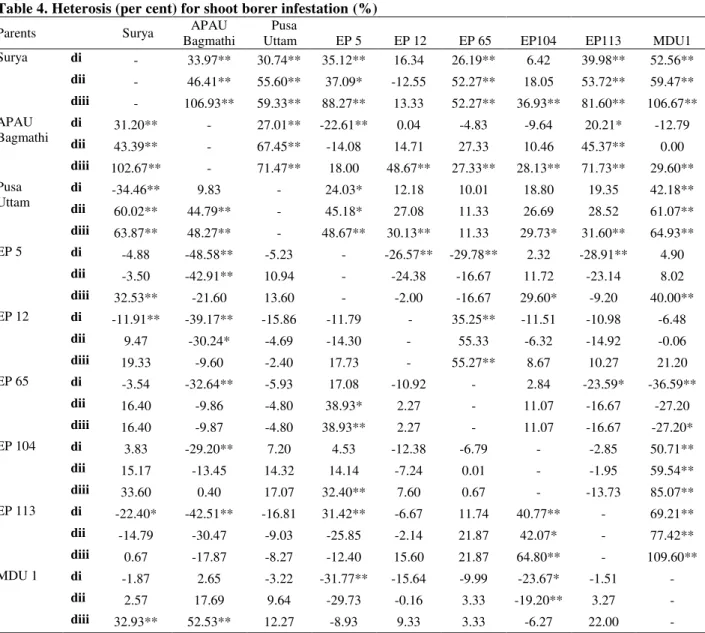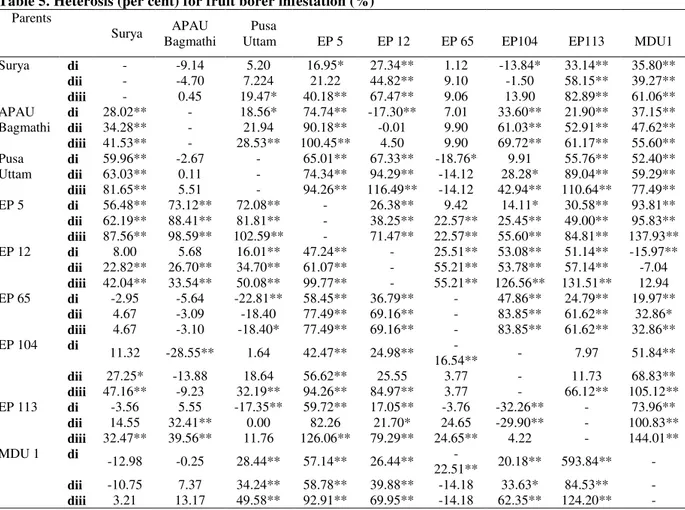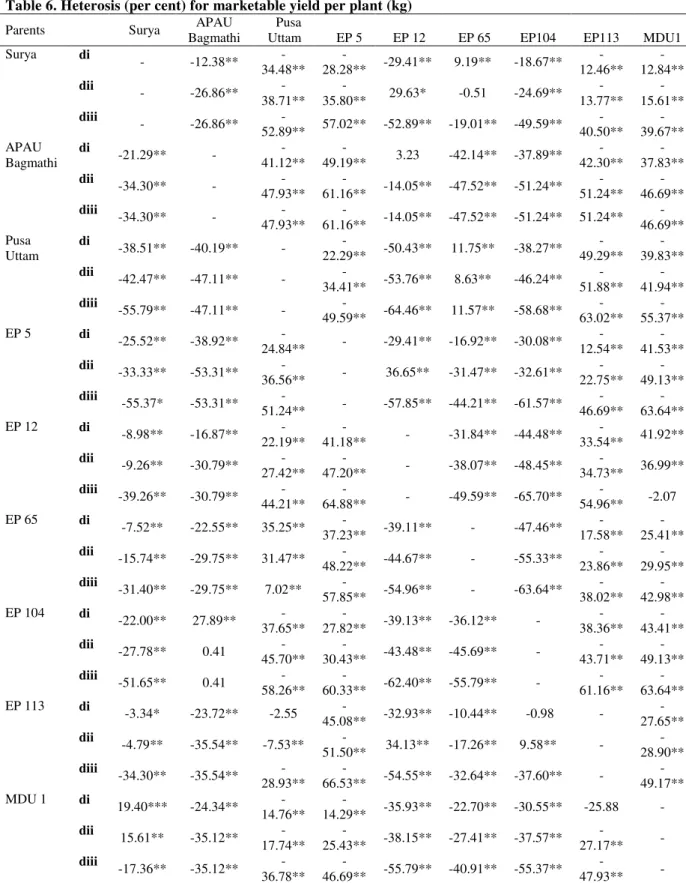ISSN 0975-928X
http://sites.google.com/site/ejplantbreeding 1061
Research Article
Per se
perforformance and heterosis for shoot and fruit borer (
Leucinodes
orbonalis
Gn) resistance and yeild in brinjal (
Solanum melongena
L.)
S.Praneetha , T.Sarasvathy, D.Veeraragavathatham and L.Pugalendhi
Horticultural College and Research Institute
Tamil Nadu Agricultural University, Coimbatore-641003 Email: prejan27@gmail.com
(Received: 30 Nov 2012; Accepted:11 Mar 2013)
Abstract
Nine parents involving full diallel mating design was used to obtain the hybrids. Heterosis effect on different characters along with fruit yield and shoot and fruit borer resistance in brinjal was estimated. The cross EP 12 x MDU 1 recorded the highest heterobeltiosis per cent followed by EP 65 x Pusa Uttam and the best parent heterosis was maximum in EP 65 x Pusa Uttam for marketable yield per plant. For shoot borer infestation the highest negative heterobeltiosis was recorded in the hybrid EP 5 x APAU Bagmathi. The hybrid EP 65 x MDU 1 registered negative significant best parent heterosis. The highest significant and negative best parent heterosis was measured by the hybrid EP 65 x Pusa Uttam (-18.40) for fruit borer infestation. Only one hybird viz., EP 65 x Pusa Uttam showed positive and significant heterosis as best parent heterosis. Hence, this hybrid can be suggested for commercial cultivation so as to get high marketable yield and also to exploit hybrid vigour for low shoot and fruit borer incidence.
Key words
Brinjal, heterosis, shoot and fruit borer resistance, marketable yield
Introduction
Brinjal is a common tropical vegetable grown commercially in almost all parts of the country. It is an often cross pollinated crop and possesses considerable diversity for plant stature, fruit yield and yield attributing characters. Thereby, it offers the chance to exploit the genetic diversity for development of hybrid varieties (Chadha et al.,1990 and Vijay and Prem Nath, 1975). Manifestation of hybrid vigour in brinjal for earliness, yield and other important characters suggested its commercial utilization either by manual hybridization or by use of self emasculating system (Kalloo, 1994). Hence, the present investigation on heterosis in brinjal was carried out to assess the extend of heterosis for commercial exploitation.
Material and methods
Nine parents viz., Surya, APAU Bagmathi, Pusa Uttam, EP 5, EP 12, EP 65, EP 104, EP 113 and MDU 1 were selected and crossed in a diallel fashion with reciprocals. A total of seventy two F1s were developed and evaluated along with
parents in a Randomised Block Design with two replications. Seedlings were planted at 60 cm x 60 cm spacing. The recommended cultural operations were carried out. The relative heterosis (di), heterobeltiosis (dii) and best parent heterosis (diii) were calculated as per the formula of Gowen (1952).
Results and discussion
Mean perforamance: The results on mean performance of shoot borer infestation, fruit borer infestation and marketable fruit yield per plant are given in Tables 1,2 and 3 respectively. The parent
APAU Bagmathi recorded the highest yield of 2.98 kg per plant among parents and 3.03 kg in EP 65 x Pusa Uttam cross among the hybrids (Table 1). The parent EP 65 recorded the lowest shoot borer infestation (7.50 per cent). Among the hybrids EP 65 x MDU 1 recorded the least shoot borer infestation of 5.46 per cent (Table 2). The lowest of 17.77 percentage as fruit borer infestation was recorded in the parent EP 65 and 14.50 percentage in cross EP 65 x Pusa Uttam (Table 3).
Heterosis: The heterosis results for shoot borer infestation, fruit borer infestation and marketable yield are given in Tables 4,5 and 6. In case of shoot borer infestation the highest negative and significant relative heterosis was recorded by the cross EP 5 x APAU Bagmathi (-48.58). Sixteen hybirds showed negative and significant relative heterosis out of the 72 crosses. Negative heterobeltiosis ranged from -42.91 to -0.61 per cent in hybrids. However, three crosses alone registered negative and significant values with maximum in the hybrid EP 5 x APAU Bagmathi. Only one cross (EP 65 x MDU 1) recorded negative significant best parent heterosis of -27.20 shoot borer infestation.
For fruit borer infestation, the maximum relative heterosis of -32.26 per cent was measured by the cross EP 113 x EP 104. The value of negative heterobeltiosis estimates was significant in only one cross EP 113 x EP 104 (-29.90). Significant and negative best parent heterosis was recorded by the hybrid EP 65 x Pusa Uttam (-18.40) for fruit borer infestation. Prabhu (2004) and Kamal Deep
ISSN 0975-928X
desirable heterosis over better parent for shoot and fruit borer infestation.
Seven hybirds registered significant and positive relative heterosis for marketable fruit yield per plant. It was maximum in the hybrid combination of EP 12 x MDU 1 (41.92). With respect to heterobeltiosis, four hybirds showed significant and positive values. The highest heterobeltiosis of 36.99 per cent was observed in the F1 of EP 12 x
MDU 1. Only one hybrid (EP 65 x Pusa Uttam) showed positive and significant best parent heterosis (7.02). High magnitude of heterosis for yield was also reported by Tiwari (1966), Singh (1980), Chadha et al. (1990) and Prasath et al. (2000) in brinjal. Rajaneesh Singh and Maurya (2005) also recorded high heterosis over better parent and over mid parent for yield.
As the cross EP 5 x APAU Bagmathi recorded desirable relative heterosis and heterobeltosis for shoot borer infestation this can be suggested as a hybrid to get reduced shoot borer infestation, thereby it would reduce the fruit borer infestation and also would increase the plant growth and yield. The hybrid EP 65 x Pusa Uttam registered desirable heterobeltiosis and best parent heterosis for fruit borer infestation and also best parent heterosis for marketable fruit yield. This hybrid can be suggested for commercial cultivation so as to get high marketable yield and also to exploit
hybrid vigour for lower borer incidence thereby the total marketable produce would be the maximum.
References
Chadha, M.L., Hoshi, A.K. and Ghai, T.R. 1990. Heterosis breeding in brinjal. Indian J. Hort. Sci., 47: 417-423
Gowen, J.W. 1952. Heterosis. Iowa state college , Ames. Iowa, USA.
Kalloo, G. 1994. Vegetable breeding volume I. C.RC. press Inc. Boca Raton, Florida pp.105-128. Kamal Deep, Bal, S.S., Ajay Kumar and Sidhu, A.S.
2006. Heterosis and combining ability studies in brinjal (Solanum melongena L.). Haryana J. Hort. Sci., 35 (1&2): 161-165.
Prabhu, M. 2004. Breeding for high yield with shoot and fruit borer (Leucinodes orbonalis guen.) resistance in brinjal (Solanum melongena L.). Ph.D., (Hort.) Thesis, Tamil Nadu Agricultural University, Coimbatore.
Prasath, D., Natararjan, S. and Thamburaj, S. 2000. Line x Tester analysis for heterosis in brinjal (solanum melongena L).The Orissa J. Hort.,
28(1):59-64.
Rajaneesh Singh, and Maurya, A.N. 2005. Hybrid vigour in eggplant (Solanum melongena L.). Prog. Hort., 37(1): 100-105.
Singh S.N. 1980. Studies on heterosis and per se performance in brinjal. Veg. Sci.,7 (1): 18-26. Tiwari, R.D. 1966. Studies on bybrid vigour in solanum
melongena. Indian Bot.Sci.,45: 138-149. Vijay, O. P. and Premnath. 1975. Studies on heterosis
and development of hybrid variety in brinjal.
Indian J. Hort., 35: 229 -234.
ISSN 0975-928X
http://sites.google.com/site/ejplantbreeding 1063
Table 1. Per se performance of parents (bold) and hybrids of brinjal for fruit yield per plant (kg)
Parents and
Hybrids Surya
APAU Bagmathi
Pusa
Uttam EP 5 EP 12 EP 65 EP 104 EP 113 MDU 1
Surya 2.04 2.16 1.45 1.39 1.62 2.43 1.53 2.14 2.05
APAU
Bagmathi 2.13 2.98 1.63 1.46 2.56 1.58 1.69 1.66 1.79
Pusa Uttam 1.58 1.61 2.32 1.86 1.39 2.53 1.34 1.45 1.58
EP 5 1.62 1.74 1.85 1.64 1.46 1.72 1.29 1.92 1.53
EP 12 1.97 2.19 1.84 1.32 2.18 1.68 1.39 1.85 2.97
EP 65 2.04 2.06 3.03 1.49 1.56 2.39 1.30 2.10 1.80
EP 104 1.58 2.90 1.32 1.46 1.35 1.31 1.87 1.33 1.39
EP 113 2.08 2.14 2.15 1.35 1.62 2.10 1.85 2.33 2.17
MDU 1 2.45 1.97 2.08 1.97 1.54 1.69 1.53 2.10 2.18
S.Ed = 0.062 C. D. (0.05) = 0.123 Note: Direct and reciprocal crosses are presented at above and below diagonal respectively
Table 2. Per se performance of parents (bold) and hybrids of brinjal for shoot borer infestation (%)
Parents and Hybrids
Surya APAU Bagmathi
Pusa
Uttam EP 5 EP 12 EP 65 EP 104 EP 113 MDU 1
Surya 10.60 15.52 11.95 14.12 8.50 11.42 10.27 13.62 15.50
APAU
Bagmathi 15.20 12.57 12.86 8.85 11.15 9.55 9.61 12.88 9.72
Pusa
Uttam 12.29 11.12 7.68 11.15 9.76 8.35 9.73 9.87 12.37
EP 5 9.94 5.88 8.52 10.30 7.35 6.25 9.72 6.81 10.50
EP 12 8.95 6.78 7.32 8.33 9.72 11.65 8.15 8.27 9.09
EP 65 8.73 6.76 7.14 10.42 7.67 7.50 8.33 6.25 5.46
EP 104 10.02 7.53 8.78 9.93 8.07 7.55 8.70 8.53 13.88
EP 113 7.55 6.16 6.88 6.57 8.67 9.14 12.36 8.86 15.72
MDU 1 9.97 11.44 8.42 6.83 8.20 7.75 7.03 9.15 9.72
S.Ed= 1.456 C. D. (0.05) = 2.898 (0.01) = 3.845 Note: Direct and reciprocal crosses are presented at above and below diagonal respectively
Table 3. Per se performance of parents (bold) and hybrids of brinjal for fruit borer infestation (%)
Parents and Hybrids
Surya APAU Bagmathi
Pusa
Uttam EP 5 EP 12 EP 65 EP 104 EP 113 MDU 1
Surya 20.55 17.85 21.23 24.91 29.76 19.38 20.24 32.50 28.62
APAU
Bagmathi 25.15 18.73 22.84 35.62 18.57 19.53 30.16 28.64 27.65 Pusa
Uttam 32.28 18.75 19.80 34.52 38.47 15.26 25.40 37.43 31.54
EP 5 33.33 35.29 36.00 22.04 30.47 21.78 27.65 32.84 42.28
EP 12 25.24 23.73 26.67 35.50 26.18 27.58 40.26 41.14 20.07
EP 65 18.60 17.22 14.50 31.54 30.06 17.77 32.67 28.72 23.61
EP 104 26.15 16.13 23.49 34.52 32.87 18.44 26.44 29.52 36.45
EP 113 23.54 24.80 19.86 40.17 31.86 22.15 18.52 28.26 43.36
MDU 1 18.34 20.11 26.58 34.28 30.20 15.25 28.85 39.84 21.59
S.Ed= 2.253 C. D. (0.05) = 4.483
ISSN 0975-928X
Table 4. Heterosis (per cent) for shoot borer infestation (%)
Parents Surya APAU
Bagmathi
Pusa
Uttam EP 5 EP 12 EP 65 EP104 EP113 MDU1
Surya di - 33.97** 30.74** 35.12** 16.34 26.19** 6.42 39.98** 52.56**
dii - 46.41** 55.60** 37.09* -12.55 52.27** 18.05 53.72** 59.47** diii - 106.93** 59.33** 88.27** 13.33 52.27** 36.93** 81.60** 106.67** APAU
Bagmathi
di 31.20** - 27.01** -22.61** 0.04 -4.83 -9.64 20.21* -12.79
dii 43.39** - 67.45** -14.08 14.71 27.33 10.46 45.37** 0.00
diii 102.67** - 71.47** 18.00 48.67** 27.33** 28.13** 71.73** 29.60** Pusa
Uttam
di -34.46** 9.83 - 24.03* 12.18 10.01 18.80 19.35 42.18**
dii 60.02** 44.79** - 45.18* 27.08 11.33 26.69 28.52 61.07**
diii 63.87** 48.27** - 48.67** 30.13** 11.33 29.73* 31.60** 64.93**
EP 5 di -4.88 -48.58** -5.23 - -26.57** -29.78** 2.32 -28.91** 4.90
dii -3.50 -42.91** 10.94 - -24.38 -16.67 11.72 -23.14 8.02
diii 32.53** -21.60 13.60 - -2.00 -16.67 29.60* -9.20 40.00**
EP 12 di -11.91** -39.17** -15.86 -11.79 - 35.25** -11.51 -10.98 -6.48
dii 9.47 -30.24* -4.69 -14.30 - 55.33 -6.32 -14.92 -0.06
diii 19.33 -9.60 -2.40 17.73 - 55.27** 8.67 10.27 21.20
EP 65 di -3.54 -32.64** -5.93 17.08 -10.92 - 2.84 -23.59* -36.59**
dii 16.40 -9.86 -4.80 38.93* 2.27 - 11.07 -16.67 -27.20
diii 16.40 -9.87 -4.80 38.93** 2.27 - 11.07 -16.67 -27.20*
EP 104 di 3.83 -29.20** 7.20 4.53 -12.38 -6.79 - -2.85 50.71**
dii 15.17 -13.45 14.32 14.14 -7.24 0.01 - -1.95 59.54**
diii 33.60 0.40 17.07 32.40** 7.60 0.67 - -13.73 85.07**
EP 113 di -22.40* -42.51** -16.81 31.42** -6.67 11.74 40.77** - 69.21**
dii -14.79 -30.47 -9.03 -25.85 -2.14 21.87 42.07* - 77.42**
diii 0.67 -17.87 -8.27 -12.40 15.60 21.87 64.80** - 109.60**
MDU 1 di -1.87 2.65 -3.22 -31.77** -15.64 -9.99 -23.67* -1.51 -
dii 2.57 17.69 9.64 -29.73 -0.16 3.33 -19.20** 3.27 -
diii 32.93** 52.53** 12.27 -8.93 9.33 3.33 -6.27 22.00 -
di= relative heterosis; dii= heterobeltiosis; diii= best parent heterosis
ISSN 0975-928X
http://sites.google.com/site/ejplantbreeding 1065
Table 5. Heterosis (per cent) for fruit borer infestation (%)
Parents
Surya APAU Bagmathi
Pusa
Uttam EP 5 EP 12 EP 65 EP104 EP113 MDU1
Surya di - -9.14 5.20 16.95* 27.34** 1.12 -13.84* 33.14** 35.80**
dii - -4.70 7.224 21.22 44.82** 9.10 -1.50 58.15** 39.27**
diii - 0.45 19.47* 40.18** 67.47** 9.06 13.90 82.89** 61.06**
APAU Bagmathi
di 28.02** - 18.56* 74.74** -17.30** 7.01 33.60** 21.90** 37.15** dii 34.28** - 21.94 90.18** -0.01 9.90 61.03** 52.91** 47.62** diii 41.53** - 28.53** 100.45** 4.50 9.90 69.72** 61.17** 55.60** Pusa
Uttam
di 59.96** -2.67 - 65.01** 67.33** -18.76* 9.91 55.76** 52.40** dii 63.03** 0.11 - 74.34** 94.29** -14.12 28.28* 89.04** 59.29** diii 81.65** 5.51 - 94.26** 116.49** -14.12 42.94** 110.64** 77.49** EP 5 di 56.48** 73.12** 72.08** - 26.38** 9.42 14.11* 30.58** 93.81** dii 62.19** 88.41** 81.81** - 38.25** 22.57** 25.45** 49.00** 95.83** diii 87.56** 98.59** 102.59** - 71.47** 22.57** 55.60** 84.81** 137.93** EP 12 di 8.00 5.68 16.01** 47.24** - 25.51** 53.08** 51.14** -15.97** dii 22.82** 26.70** 34.70** 61.07** - 55.21** 53.78** 57.14** -7.04 diii 42.04** 33.54** 50.08** 99.77** - 55.21** 126.56** 131.51** 12.94 EP 65 di -2.95 -5.64 -22.81** 58.45** 36.79** - 47.86** 24.79** 19.97**
dii 4.67 -3.09 -18.40 77.49** 69.16** - 83.85** 61.62** 32.86* diii 4.67 -3.10 -18.40* 77.49** 69.16** - 83.85** 61.62** 32.86** EP 104 di
11.32 -28.55** 1.64 42.47** 24.98**
-16.54** - 7.97 51.84**
dii 27.25* -13.88 18.64 56.62** 25.55 3.77 - 11.73 68.83**
diii 47.16** -9.23 32.19** 94.26** 84.97** 3.77 - 66.12** 105.12** EP 113 di -3.56 5.55 -17.35** 59.72** 17.05** -3.76 -32.26** - 73.96**
dii 14.55 32.41** 0.00 82.26 21.70* 24.65 -29.90** - 100.83**
diii 32.47** 39.56** 11.76 126.06** 79.29** 24.65** 4.22 - 144.01** MDU 1 di
-12.98 -0.25 28.44** 57.14** 26.44**
-22.51** 20.18** 593.84** - dii -10.75 7.37 34.24** 58.78** 39.88** -14.18 33.63* 84.53** - diii 3.21 13.17 49.58** 92.91** 69.95** -14.18 62.35** 124.20** - di= relative heterosis; dii= heterobeltiosis; diii= best parent heterosis
ISSN 0975-928X
Table 6. Heterosis (per cent) for marketable yield per plant (kg)
Parents Surya APAU
Bagmathi
Pusa
Uttam EP 5 EP 12 EP 65 EP104 EP113 MDU1
Surya di
- -12.38**
-34.48**
-28.28** -29.41** 9.19** -18.67** -12.46**
-12.84** dii
- -26.86**
-38.71**
-35.80** 29.63* -0.51 -24.69** -13.77**
-15.61** diii
- -26.86**
-52.89** 57.02** -52.89** -19.01** -49.59** -40.50** -39.67** APAU Bagmathi di
-21.29** -
-41.12**
-49.19** 3.23 -42.14** -37.89** -42.30**
-37.83** dii
-34.30** -
-47.93**
-61.16** -14.05** -47.52** -51.24** -51.24**
-46.69** diii
-34.30** -
-47.93**
-61.16** -14.05** -47.52** -51.24** 51.24** -46.69** Pusa
Uttam
di
-38.51** -40.19** -
-22.29** -50.43** 11.75** -38.27** -49.29**
-39.83** dii
-42.47** -47.11** -
-34.41** -53.76** 8.63** -46.24** -51.88**
-41.94** diii
-55.79** -47.11** -
-49.59** -64.46** 11.57** -58.68** -63.02**
-55.37**
EP 5 di
-25.52** -38.92**
-24.84** - -29.41** -16.92** -30.08** -12.54**
-41.53** dii
-33.33** -53.31**
-36.56** - 36.65** -31.47** -32.61** -22.75**
-49.13** diii
-55.37* -53.31**
-51.24** - -57.85** -44.21** -61.57** -46.69**
-63.64**
EP 12 di
-8.98** -16.87** -22.19**
-41.18** - -31.84** -44.48**
-33.54** 41.92** dii
-9.26** -30.79** -27.42**
-47.20** - -38.07** -48.45**
-34.73** 36.99** diii
-39.26** -30.79** -44.21**
-64.88** - -49.59** -65.70**
-54.96** -2.07
EP 65 di
-7.52** -22.55** 35.25**
-37.23** -39.11** - -47.46** -17.58**
-25.41** dii
-15.74** -29.75** 31.47**
-48.22** -44.67** - -55.33** -23.86**
-29.95** diii
-31.40** -29.75** 7.02**
-57.85** -54.96** - -63.64** -38.02**
-42.98** EP 104 di
-22.00** 27.89** -37.65**
-27.82** -39.13** -36.12** -
-38.36**
-43.41** dii
-27.78** 0.41
-45.70**
-30.43** -43.48** -45.69** -
-43.71**
-49.13** diii
-51.65** 0.41
-58.26**
-60.33** -62.40** -55.79** -
-61.16**
-63.64** EP 113 di
-3.34* -23.72** -2.55
-45.08** -32.93** -10.44** -0.98 -
-27.65** dii
-4.79** -35.54** -7.53**
-51.50** 34.13** -17.26** 9.58** -
-28.90** diii
-34.30** -35.54** -28.93**
-66.53** -54.55** -32.64** -37.60** -
-49.17**
MDU 1 di
19.40*** -24.34** -14.76**
-14.29** -35.93** -22.70** -30.55** -25.88 - dii
15.61** -35.12** -17.74**
-25.43** -38.15** -27.41** -37.57**
-27.17** - diii
-17.36** -35.12** -36.78**
-46.69** -55.79** -40.91** -55.37**
-47.93** - di= relative heterosis; dii= heterobeltiosis; diii= best parent heterosis



